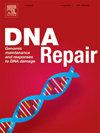The model moss Physcomitrium patens relies heavily on homologous recombination to repair DNA double-strand breaks
IF 2.7
3区 生物学
Q2 GENETICS & HEREDITY
引用次数: 0
Abstract
We previously showed that moss (Physcomitrium patens) cells are highly radioresistant and suggested that P. patens uses an efficient mechanism to repair DNA double-strand breaks (DSBs). Homologous recombination (HR), canonical non-homologous end-joining, and alternative end-joining are the major pathways used to repair DSBs. To identify the DSB repair pathway used in P. patens, we generated knockout (KO) plants for LIG4, POLQ, and RAD51B, which play major roles in canonical non-homologous end-joining, alternative end-joining, and HR, respectively. The KO plants were irradiated with γ-rays, and their radioresistance was evaluated. Although wild-type (WT), lig4, and polq plants showed comparable radioresistance, that of rad51b plants was drastically reduced. The radioresistance of rad51b polq plants was further reduced, whereas that of rad51b lig4 plants was similar to that of rad51b. Under γ-irradiation conditions at which the dry weight of the plants was reduced to 50 %, single base substitutions were predominantly induced in WT, lig4, and polq plants. In contrast, drastic sequence alterations, such as large deletions with or without insertions, chromosome inversions, or translocations, were induced in rad51b and rad51b polq plants. These results suggest that P. patens primarily uses the HR pathway for DSB repair, even in the presence of other pathways. Flow cytometry analysis of the WT and KO plants revealed that the majority of cells subjected to irradiation were in late S/G2 phase, suggesting that the sister chromatid served as a template for HR.
模式苔藓壶状菌主要依靠同源重组修复DNA双链断裂
我们之前的研究表明,苔藓(Physcomitrium patens)细胞具有高度的抗辐射能力,并表明patens利用一种有效的机制来修复DNA双链断裂(DSBs)。同源重组(HR)、典型非同源末端连接和选择性末端连接是修复dsb的主要途径。为了确定植物中DSB的修复途径,我们构建了LIG4、POLQ和RAD51B的敲除(KO)植株,它们分别在典型的非同源末端连接、替代末端连接和HR中起主要作用。用γ射线照射KO植株,并对其辐射抗性进行评价。尽管野生型(WT)、lig4和polq植物表现出相当的辐射抗性,但rad51b植物的辐射抗性却急剧下降。rad51b polq植株的抗辐射能力进一步降低,而rad51b lig4植株的抗辐射能力与rad51b相似。在干重降低到50% %的γ辐照条件下,WT、lig4和polq植株主要发生单碱基取代。相比之下,在rad51b和rad51b polq植物中诱导了剧烈的序列改变,如插入或不插入的大缺失、染色体倒位或易位。这些结果表明,即使存在其他途径,P. patens也主要使用HR途径进行DSB修复。对WT和KO植株的流式细胞术分析显示,辐照后的大部分细胞处于S/G2期晚期,提示姐妹染色单体作为HR的模板。
本文章由计算机程序翻译,如有差异,请以英文原文为准。
求助全文
约1分钟内获得全文
求助全文
来源期刊

DNA Repair
生物-毒理学
CiteScore
7.60
自引率
5.30%
发文量
91
审稿时长
59 days
期刊介绍:
DNA Repair provides a forum for the comprehensive coverage of DNA repair and cellular responses to DNA damage. The journal publishes original observations on genetic, cellular, biochemical, structural and molecular aspects of DNA repair, mutagenesis, cell cycle regulation, apoptosis and other biological responses in cells exposed to genomic insult, as well as their relationship to human disease.
DNA Repair publishes full-length research articles, brief reports on research, and reviews. The journal welcomes articles describing databases, methods and new technologies supporting research on DNA repair and responses to DNA damage. Letters to the Editor, hot topics and classics in DNA repair, historical reflections, book reviews and meeting reports also will be considered for publication.
 求助内容:
求助内容: 应助结果提醒方式:
应助结果提醒方式:


